
Pandanus is a genus of monocots with about 578 accepted species. They are palm-like, dioecious trees and shrubs native to the Old World tropics and subtropics. The greatest number of species are found in Madagascar and Malaysia. Common names include pandan, screw palm and screw pine. They are classified in the order Pandanales, family Pandanaceae.
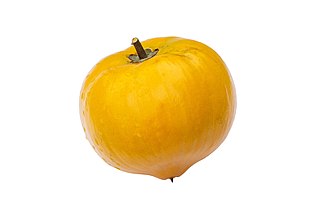
Pouteria campechiana is an evergreen tree native to, and cultivated in, southern Mexico, Belize, Guatemala, and El Salvador. It is cultivated in other countries, such as India, Costa Rica, Brazil, the United States, the Dominican Republic, Australia, Cambodia, Vietnam, Indonesia, Sri Lanka, Nigeria, and the Philippines. The edible part of the tree is its fruit, which is colloquially known as an egg fruit.

Pandanus tectorius is a species of Pandanus (screwpine) that is native to Malesia, Papuasia, eastern Australia, and the Pacific Islands. It grows in the coastal lowlands typically near the edge of the ocean. Common names in English include thatch screwpine, Tahitian screwpine, hala tree and pandanus. The fruit is edible and sometimes known as hala fruit.

Piper excelsum of the pepper family (Piperaceae) and commonly known as kawakawa, is a small tree of which the subspecies P. excelsum subsp. excelsum is endemic to New Zealand; the subspecies P. e. subsp. psittacorum is found on Lord Howe Island, Norfolk Island and the Kermadec Islands.
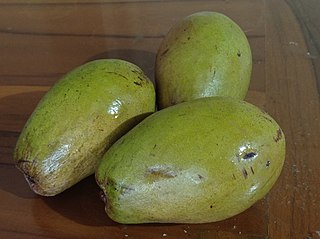
Mangifera caesia is a species of flowering plant in the cashew family, Anacardiaceae. Known in English as jack or white mango, among other names. It belongs to the same genus as the mango and is widely cultivated in areas of Indonesia, Malaysia, Singapore, Brunei, Papua New Guinea and the Philippines.

Pleiogynium timoriense, commonly known as the Burdekin plum, sweet plum, tulip plum, or in the Djabugay language guybalum, is a medium-sized fruit-bearing tree in the cashew and mango family Anacardiaceae native to Malesia, Australia and the Pacific Islands.

Pandanus spiralis is a small tree in the family Pandanaceae native to northern Australia. It is commonly called pandanus, spring pandanus, screw palm or screw pine, although it is neither a palm nor a pine.

Pandanus utilis, the common screwpine is, despite its name, a monocot and not a pine. It is native to Madagascar and naturalised in Mauritius and the Seychelles.

Antidesma bunius is a species of fruit tree in the family Phyllanthaceae. It is native to South Asia, Southeast Asia, Melanesia, and northern Australia. It is commonly known as bignay, after its native name in the Philippines, where the fruits are commonly used for making bignay wine and jams. It is also known more ambiguously as Chinese laurel, Queensland cherry, salamander tree, wild cherry, and currant tree.
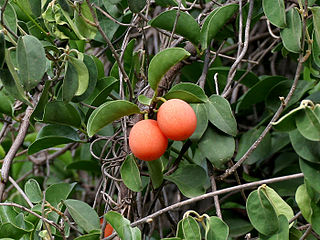
Ximenia americana, commonly known as tallow wood, hog plum, yellow plum, sea lemon, or pi'ut (Chamorro), is bush-forming shrub/small tree; a species from the Ximenia genus in the Olacaceae family. It is mainly found in the tropics, ranging from Africa, India and southeast Asia, to Australia, New Zealand, Pacific Islands, West Indies, Central, North and South America. It is especially common in Africa and South America. It is not domesticated so it is only found occurring in the wild.
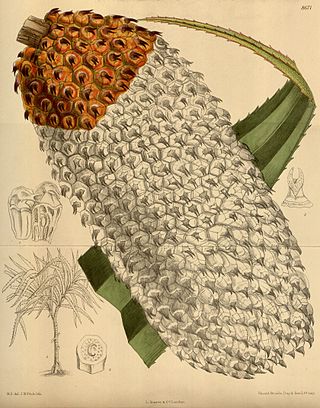
Pandanus furcatus Roxb., also known as korr, pandan or Himalayan/Nepal screw pine, is native to the Sikkim Himalaya of Northeast India, Bhutan and Nepal, Malaysia, Indonesia and West Africa, and occurs on moist and shady slopes of ravines between 300 and 1500 m. As might be expected it is cold-resistant and able to tolerate occasional light frost, slowly growing to a tall branched tree - about 17 m at maturity - and perched on stilt-like aerial roots. The crown is made up of 5 m long, pale-green leaves, with finely toothed margins, while its fruits are sweet-tasting and edible. The leathery flower spathes are golden-yellow, the lowermost are largest and about 1m in length. These give rise to cone-like fruits, 15–25 cm long, that are bright orange to red when mature and consist of 5-6 angled drupes.
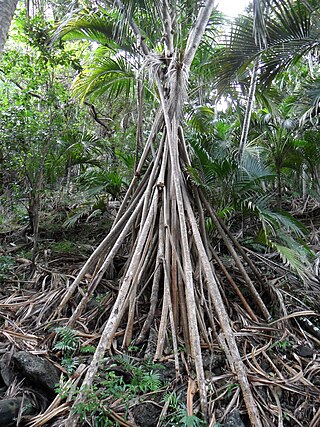
Pandanus forsteri , commonly known as forky-tree or forkedy-tree, is a flowering plant in the screwpine family. The specific epithet honours either Johann Forster or Georg Forster, father and son German botanists, who accompanied James Cook as naturalists on his second voyage (1772–1775).

Artocarpus sericarpus, the peluntan, pedalai, gumihan or terap bulu, is a tropical evergreen tree species of the family Moraceae. It is the cousin of jackfruit and breadfruit.

Pandanus heterocarpus is a species of plant in the family Pandanaceae. It is commonly called the "Rodrigues screwpine", known locally as "vacoa parasol" or "vacoa cale rouge". It is endemic to the island of Rodrigues.

The karuka is a species of tree in the screwpine family (Pandanaceae) and an important regional food crop in New Guinea. The nuts are more nutritious than coconuts, and are so popular that villagers in the highlands will move their entire households closer to trees for the harvest season.

Pandanus simplex is an economically important species of Pandanus (screwpine) endemic to the Philippines. It is commonly known as karagumoy or kalagimay. Its leaves and fibers are used widely in the Philippines for thatching, ropes, and weaving various traditional handicrafts like baskets and mats.
Pandanus whitmeeanus, commonly known as the Samoan pandanus, is a species of Pandanus (screwpine) believed to be native to Vanuatu. It has been introduced to Samoa, Tonga, the Cook Islands, and the Hoorn Islands by Austronesian voyagers. It is also known in Samoan and Tongan as ‘ara ‘āmoa or paogo.
Garcinia binucao is a species of flowering plant in the Clusiaceae family. It is commonly known as binukaw or batuan, is a species of Garcinia endemic to the Philippines. It is not cultivated, though its edible fruits are harvested from the wild for use as a souring agent in some Filipino dishes.
Pandanus concretus is a dioecious tree in the screwpine genus. It is endemic to Madagascar, found in Toliara province. Pandanus concretus is the accepted name, but it has also been called Pandanus centrifugalis, P. dauphinensis, P. erectus and P. madagascarensis.
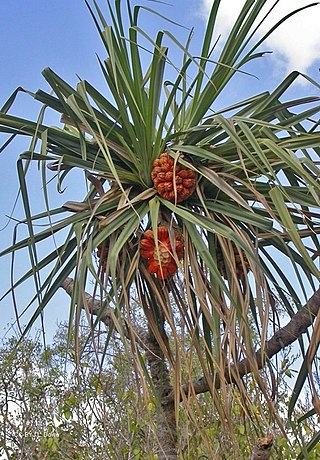
Pandanus cookii, commonly known as Cook's pandan, Cook's screwpine or simply screwpine, is a tree in the family Pandanaceae which is endemic to coastal and sub-coastal parts of tropical Queensland, Australia. It grows to around 10 m (33 ft) in height with an open habit, long narrow leaves up to 180 by 8 cm and prop roots up to around 30 cm (12 in) long.



















